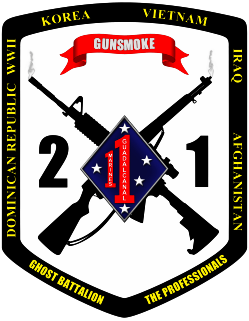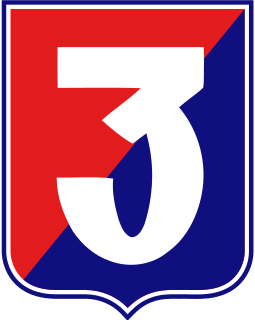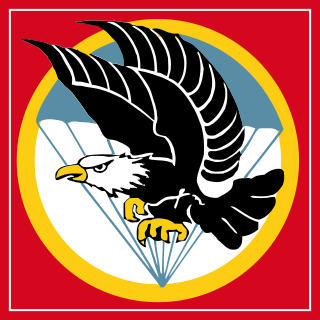External links
| Leadership |  | ||||
|---|---|---|---|---|---|
| Major commands | |||||
| Auxiliary | |||||
| Structure | |||||
| Personnel and training |
| ||||
| Uniforms and equipment | |||||
| History and traditions |
| ||||
| 1st Searchlight Battery | |
|---|---|
| Country | United States |
| Branch | USMC |
| Part of | 12th Marine Regiment 3rd Marine Division |
| Garrison/HQ | MCAGCC 29 Palms |
| Engagements | Vietnam War |
1st Searchlight Battery was a United States Marine Corps unit formed during the Vietnam War to monitor the "Electronic Wall of Defense" that was set up along the Vietnamese Demilitarized Zone. They fell under the 12th Marine Regiment and the 3rd Marine Division.
1st Searchlight Battery was a new unit organized, supervised and controlled by the United States Secretary of Defense, Robert McNamara and was part of the "Electronic Wall of Defense".
The Battery began at Marine Corps Base Twentynine Palms, California. It was the first unit in the history of the Marine Corps with infrared/xeon arc technology searchlights.
There were 122 men in the Battery: 6 Officers, 113 Enlisted and 3 Enlisted U.S. Navy Corpsmen. Commanding Officer was Captain Victor B. Snider.
Deployed to South Vietnam on the USS Paul Revere, departing the continental limits of the United States from National City, California, on May 31, 1967. All personnel had "Secret" security clearance.
On June 27, 1967, the Battery arrived in Da Nang, South Vietnam. At 05:30 on June 28 it departed Da Nang for Đông Hà Combat Base, arriving there on June 29. The Battery HQ was built in Đông Hà.
Attached to 12th Marine Regiment, 3d Marine Division (Rein) FMF.
There were 18 M274 Mechanical Mules converted with generators and the searchlight. Each searchlight had a 23" Dual Blade. They had infrared (viewed with M-18 binoculars) and white light capability. The white light had a Xenon Arc, with 75 million candlepower.
On July 3 the Battery began deployment of the 3 platoons to seven areas of the Quảng Trị Province/I Corps: Con Thien, Cửa Việt, Khe Sanh, Gio Linh, Đông Hà, Cam Lộ, Camp Carroll and Thừa Thiên Provinces: (Phu Bai and Camp Evans).
The primary use of the searchlight was for perimeter defense. The lights were also used in six major combat operations with excellent results.
Significant operations participated in:
|
|
|

The 3rd Marine Division is an infantry division of the United States Marine Corps based at Camp Courtney, Marine Corps Base Camp Smedley D. Butler and Okinawa, Japan. It is one of three active duty divisions in the Marine Corps and together with the 1st Marine Aircraft Wing (1stMAW) and the 3rd Marine Logistics Group forms the III Marine Expeditionary Force. The division was first formed during World War II and saw four years of continuous combat in the Vietnam War.

The M42 40 mm Self-Propelled Anti-Aircraft Gun, or "Duster," is an American armored light air-defense gun built for the United States Army from 1952 until December 1960, in service until 1988. Production of this vehicle was performed by the tank division of the General Motors Corporation. It used components from the M41 light tank and was constructed of all-welded steel.

2nd Battalion, 1st Marines (2/1) is an infantry battalion in the United States Marine Corps based out of Camp Horno on Marine Corps Base Camp Pendleton, California. Nicknamed "The Professionals," the battalion consists of approximately 1,200 Marines and sailors. Normally they fall under the command of the 1st Marine Regiment and the 1st Marine Division.

The 12th Marine Regiment is an artillery regiment of the United States Marine Corps based at Camp Smedley Butler, Okinawa, Japan. Nicknamed "Thunder and Steel," the regiment falls under the command of the 3rd Marine Division.

1st Battalion 11th Marines (1/11) is an artillery battalion comprising four firing batteries and a Headquarters battery. The battalion is stationed at the Marine Corps Base Camp Pendleton in California. Its primary weapon system is the M777 lightweight howitzer. The battalion is under the command of the 11th Marine Regiment, part of the 1st Marine Division.

The 3d Medical Battalion is a medical support unit of the United States Marine Corps and is headquartered at Camp Foster, Okinawa, Japan. The unit falls under the command of 3rd Marine Logistics Group.

The First Battle of Quảng Trị resulted in the first major victory for the People's Army of Vietnam (PAVN) during the Easter Offensive of 1972. Quảng Trị Province was a major battleground for the opposing forces during the Vietnam War. As South Vietnamese soldiers were gradually replacing their American counterparts, North Vietnam's General Văn Tiến Dũng was preparing to engage three of his divisions in the province. Just months before the battle, the Army of the Republic of Vietnam (ARVN) deployed its newly formed 3rd Division to the areas along the Vietnamese Demilitarized Zone (DMZ) to take over former US bases. North Vietnamese forces deployed against the inexperienced ARVN 3rd Division included the PAVN 304th, 308th and 324B Divisions.

The Republic of Vietnam Marine Division was part of the armed forces of South Vietnam. It was established by Ngo Dinh Diem in 1954 when he was Prime Minister of the State of Vietnam, which became the Republic of Vietnam in 1955. The longest-serving commander was Lieutenant General Le Nguyen Khang. In 1969, the VNMC had a strength of 9,300, 15,000 by 1973., and 20,000 by 1975.

PHASE II of the Tet Offensive of 1968 was launched by the People's Army of Vietnam (PAVN) and Viet Cong (VC) against targets throughout South Vietnam, including Saigon from 29 April to 30 May 1968. The May Offensive was considered much bloodier than the initial phase of the Tet Offensive. US casualties across South Vietnam were 2,169 killed for the entire month of May making it the deadliest month of the entire Vietnam War for U.S. forces, while South Vietnamese losses were 2,054 killed. PAVN/VC losses exceeded 24,000 killed and over 2,000 captured. The May Offensive was a costly defeat for the PAVN/VC.

The Third Force Reconnaissance Company, or 3rd FORECON, are responsible in deep reconnaissance and direct action support, and largely tasked in remote sensor emplacement for ground combat elements of the Marine Air-Ground Task Force.

The I Corps Tactical Zone was a corps of the Army of the Republic of Vietnam (ARVN), the army of the nation state of South Vietnam that existed from 1955 to 1975. It was one of four corps of the ARVN. This was the northernmost region of South Vietnam, bordering North Vietnam. These five provinces are Quảng Trị Province,, Thừa Thiên-Huế Province,, Quảng Nam Province,, Quảng Tín Province, and Quảng Ngãi Province,. The region included the DMZ area where 3rd Marine Division intelligence estimated the combat strength of NVA and VC forces in January 1968 was 40,943 troops.

The 1st Division of the Army of the Republic of Vietnam (ARVN)—the army of the nation state of South Vietnam that existed from 1955 to 1975—was part of the I Corps that oversaw the northernmost region of South Vietnam, the centre of Vietnam.

The 3rd Division of the Army of the Republic of Vietnam (ARVN)—the army of the nation state of South Vietnam that existed from 1955 to 1975—was part of the I Corps that oversaw the northernmost region of South Vietnam, the centre of Vietnam.

The Vietnamese Airborne Division was one of the earliest components of the Republic of Vietnam Military Forces. The Vietnamese Airborne Division began as companies organised in 1948, prior to any agreement over armed forces in Vietnam. After the partition of Vietnam, it became a part of the Army of the Republic of Vietnam. This division had its distinct origins in French-trained paratrooper battalions, with predecessor battalions participating in major battles including Dien Bien Phu and retained distinct uniforms and regalia. With the formation of an independent republic, the colonial paratroopers were dissolved, however regalia and aesthetics alongside the nickname "Bawouans" would be retained.
Operation Prairie IV was an operation conducted by the United States Marine Corps in the area around Con Thien, South Vietnam known as Leatherneck Square from 20 April until 17 May 1967. During the course of the fighting Marine casualties were 164 killed 1,240 wounded while claiming the People's Army of Vietnam (PAVN) suffered 505 killed and 9 taken as prisoners of war.
The 324th Division is an infantry division of the 4th Military Region.
The 320th Division or Đồng Bằng Division is a formation and one of the six original "Steel and Iron Divisions" of the Vietnam People's Army. It was established in January 1951.

The Hue–Da Nang Campaign was a series of military actions conducted by the People's Army of Vietnam (PAVN) against the Army of the Republic of Vietnam (ARVN) during the Vietnam War, also known in Vietnam as the American War. The campaign was centred on the cities of Huế and Da Nang, with secondary fronts in the provinces of Quảng Trị and Quảng Ngãi. The campaign began on March 5 and concluded on April 2, 1975.
The 325th Infantry Division is a division of the People's Army of Vietnam, first formed in March 1951 from independent units in Thừa Thiên, it is likely that it only became fully operational in mid-1952. It was one of the 6 original "Iron and Steel" Divisions of the Viet Minh.
Đông Hà Combat Base is a former U.S. Marine Corps and U.S. Army base northwest of Quảng Trị in central Vietnam. The base was first used by the 4th Marines in late April 1966. In mid-July Đông Hà was used by the Marines as a helicopter base and logistics area. Numerous US marine and army units rotated through the base, and several artillery units were based there.